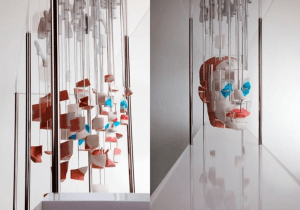We’re bombarded with visuals daily – TVs, phones, billboards – a constant stream of flat screens vying for our attention. But what if there was a display technology that could break free from the mundane and create truly captivating experiences? Enter the world of anamorphic LED displays.
What is Anamorphosis?
Anamorphosis is a visual art technique that involves creating a distorted projection or perspective of an image, which appears normal only when viewed from a specific angle or through a special device, such as a curved mirror. This method plays with the viewer’s perception, transforming seemingly chaotic shapes into coherent images when observed from the correct vantage point.
Anamorphosis has historical roots in art, with famous examples like Hans Holbein’s “The Ambassadors,” and continues to captivate modern audiences in various applications, including art, architecture, advertising, and digital media, notably in the creation of immersive anamorphic LED displays.
A Brief History of Anamorphic Techniques
-
Ancient Origins: Anamorphic techniques date back to prehistoric times. Cave paintings during the Stone Age used the oblique angles of cave walls to create illusions. These early artists ingeniously manipulated perspective to convey their messages.
-
Renaissance Art: During the Renaissance, anamorphosis appeared in masterpieces like Leonardo da Vinci’s “Leonardo’s Eye” and Hans Holbein the Younger’s “The Ambassadors.” The latter painting features a distorted grey slash in the bottom left corner. When viewed from the artist-suggested vantage point (hint: imagine a staircase), a hidden skull emerges.
-
17th Century Revival: Anamorphic illusions resurfaced in the 17th century, both in Italy and China. In Rome’s Church of St. Ignazio, artist Andrew Pazzo created the appearance of a dome on a flat ceiling. Edgar Allan Poe even referenced anamorphosis in his short story “Lieia,” describing a room filled with “simple monstrosities” that transformed into “an endless succession of ghastly forms” as the narrator moved through it.
-
World War I Patriotism: Photographer Arthur Mole used anamorphic techniques during World War I to create patriotic images. By assembling massive groups of soldiers and reservists, he formed recognizable pictures when viewed from specific towers.

Anamorphic Illusions in Everyday Life
You’ve likely encountered anamorphosis without realizing it:
-
IMAX Theaters: IMAX screens use anamorphic projection to immerse audiences in larger-than-life visuals.
-
Road Signs: Ever seen the words “Bus Lane” on the road? These are modern-day anamorphic illusions, guiding drivers from specific angles.
-
Street Art: Scrolling through social media, you might have paused at an image of mind-bending street art. Anamorphic illusions play a role here too.
The Future of Anamorphic Illusions on Digital Displays
As LED walls become more accessible, they offer a new canvas for high-impact digital art. Anamorphic illusions, often described as “glasses-free” or 3D “naked eye,” are generating buzz—especially on social media. Imagine captivating passersby with mind-bending visuals on large digital billboards, all achieved through anamorphic magic.
So next time you encounter an awe-inspiring illusion, remember the ancient art form that continues to evolve in our digital age. Anamorphic displays are more than just pixels—they’re gateways to wonder and imagination.
Conclusion
As technology continues to evolve, we can expect even more sophisticated and immersive anamorphic displays to emerge, pushing the boundaries of what is possible in visual storytelling. Whether used in urban landscapes, retail environments, or entertainment venues, anamorphic LED displays are set to redefine our perception of digital media, offering a glimpse into the future of visual communication. Embracing this cutting-edge technology not only enhances viewer experience but also opens new avenues for creativity and innovation in various industries.
In the ever-competitive world of digital content, anamorphic LED displays stand out as a game-changer, proving that the future of display technology is not just about clarity and brightness, but also about creating unforgettable experiences that resonate with audiences on a deeper level.
FAQs
Are Anamorphic LED Displays expensive?
The cost can vary depending on the size, resolution, and complexity of the display. However, advancements in technology are making them more affordable.
What is the future of Anamorphic LED Displays?
As technology continues to develop, we can expect to see even more innovative and interactive applications of Anamorphic LED Displays. They are likely to become a more prominent feature in urban environments, advertising, and the art world.
Is Anamorphic LED Display a new technology?
The concept of anamorphosis has been around for centuries, but Anamorphic LED Displays are a relatively new development. They combine traditional anamorphic techniques with modern LED display technology to create a unique and innovative art form.





